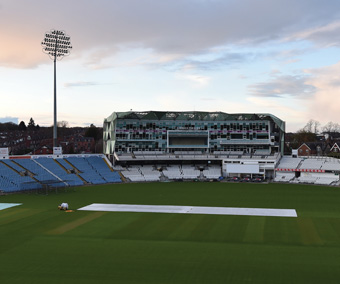Anti-climate change protesters and a contentious action by the Australian team have raised risks in men’s Ashes cricket – the third match in the five-match series begins at Leeds tomorrow (pictured, Headingley ground). As ever, there’s nothing new under the sun, writes Mark Rowe.
The advice from the English cricket authorities to players was ‘to avoid all contact with the demonstrators whatsoever’; except that they would let players use ‘restraint’ on anyone damaging the pitch. Then cricketers had to ‘use the minimum possible force’ and ‘must at all costs avoid becoming involved in any strong physical contact’.
The advice did not say how a cricketer – sticking out as a target, wearing white – could avoid ‘contact’ when invaders ran at him. Instead the advice went on: “It would be a greater mistake for the players to get involved in a free fight and successfully protect the pitch than it would be for them to stand back and let it be damaged.” That would seem to accept that England players might throw punches – either because they wanted nothing better than to clout protesters, or in sheer self-defence – on the televised field of a Test match, at the home of cricket.
The advice dates from May 1970, on the eve of a controversial tour by apartheid-era South Africa, which the English governing body of cricket cancelled days before the tourists were due to set off. At the Lord’s Test match between England and Australia last week, Just Stop Oil supporters ran on the field of play, and one of England’s players Jonny Bairstow was pictured (including on the JSO website) carrying one of the intruders off.
Why would any protesters target a game of cricket? As JSO say, theirs is an ‘indefinite campaign of civil resistance’, so they have to keep finding places to protest. They can always find an excuse; in the case of Lord’s, JSO point to the club’s ‘principal partner’ as JP Morgan, described by JSO as ‘the world’s worst “fossil bank”’. JSO have protested at other sporting events, such as the world snooker championship at the Crucible in Sheffield; and carried out ‘sow march’ tactics on bridges and elsewhere on roads in London; and inside Harrods department store, for example.
In sum, protesters go where they can; and where they will be seen and publicised; the more photogenic and popular the place, the better. Thus the anti-apartheid protest of 1969-70 that climaxed in the cancellation of the South African tour – a rare example of a complete success for a protest campaign – began with Peter (now Lord) Hain and a handful of others disrupting a tennis tournament in Bristol in summer 1969. Sport, in brief, makes an easy or ideal target: venues have to let in ticketed or otherwise paying customers, and a protester can be among them, whereas a power station (let’s say) hardly invites the same access.
Just as airports have had to balance convenience of passengers with security – and the cost of extra lanes to check passengers and their hand luggage when they go airside, and the time element of passengers having flights to catch – so venues have to weigh up how carefully they check bags. Often either fans have to queue for hours, given the sheer number of people that have to pass through a limited number of entry points – Wimbledon’s capacity of 42,000 is regularly reached during the midsummer championship fortnight; or, fans turn up expecting entry at the last minute or quarter-hour, and security is then under pressure to let people through with less of a check than earlier; a fact of human nature that protesters or others (such as football fans with flares they want to let off, to be ‘ultras’, as featured in the March print edition of Professional Security Magazine) can exploit.
Besides JSO, sport attracts everyone – demonstrator, streaker, terrorist, hoax bomb threat-maker, fans riled by something turning out not how they would like (ignoring the fact that in a team sport, someone must lose) and nutcase generally. Venues have been used to dealing with them for decades: above all, at the London 2012 Olympics. Police, stewards and SIA-badged contract security have proved equal to what’s thrown (including literally) at them, even the mass hooliganism of the Euro championship final at Wembley in summer 2021, when ticketless thousands tried to force their way in.
Which makes the reported meeting of Home Secretary Suella Braverman, Culture Secretary Lucy Frazer, police and sports authorities pointless. Indeed, the Home Office has caused part of the problem, by partly causing the displacement of protest. The Public Order Act 2023, begun by the previous Home Secretary Priti Patel, criminalised protest that causes ‘serious disruption’, to the law-abiding ‘accessing essential goods or essential services’ – whether ‘the supply of money, food, water, energy or fuel’, ‘a system of communication’, ‘a place of worship’, ‘a transport facility’, ‘an educational institution’, or ‘a service relating to health’. Earlier in the Act, was an offence of ‘interference with use or operation of key national infrastructure’, infrastructure defined as:
(a)road transport,
(b)rail,
(c)air transport,
(e)downstream oil infrastructure,
(f)downstream gas,
(g)onshore oil and gas exploration and production,
(h)onshore electricity generation, or
(i)newspaper printing.
That was meant to counter pre-2022 Extinction Rebellion and protests against the HS2 rail line, such as tunnelling in Euston Gardens. Despite the best efforts of the Home Office law drafters to cover all the bases, the law hasn’t stopped protest, whether slow marching or against sports venues such as Aintree; and the Home Office was reduced last month to giving police a ‘clearer’ definition of serious disruption, and the Home Secretary left to spluttering that ‘the public shouldn’t have to take matters in their own hands’, referring to angry delayed people handling protesters (like Bairstow). JSO promptly commented that they would take no notice.









